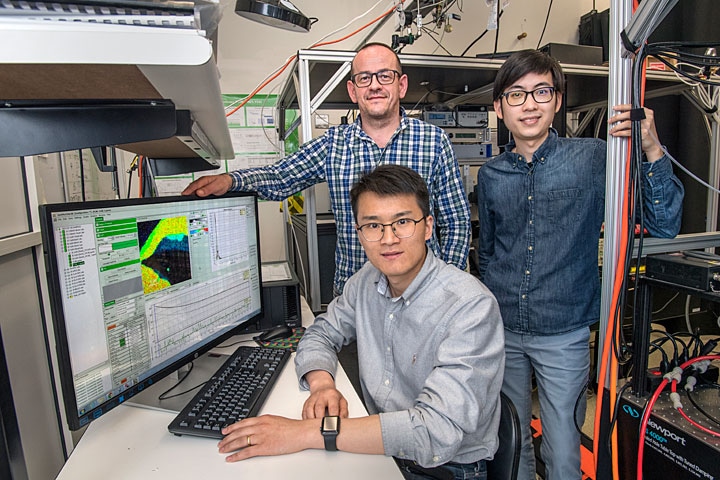Jun 13 2019
Plants and certain types of bacteria depend on a light-harvesting protein complex comprising of molecules known as chromophores to absorb incoming sunlight. This complex directs solar energy to the photosynthetic reaction center, where it is turned into chemical energy to handle metabolic processes.
 Mingxing Li (sitting) and Mircea Cotlet (left) of Brookhaven Lab's Center for Functional Nanomaterials and Jia-Shiang Chen of Stony Brook University's Materials Science and Chemical Engineering Department used a self-assembly technique based on the interactions between electrically charged particles (opposite charges attract; like charges repel) to create a “nanohybrid” structure that contains both biologically derived and nonliving materials. Compared to the nonhybrid counterparts, the nanohybrid shows increased energy transfer efficiency and photoresponsivity, or response to light—ideal characteristics for solar cell applications. (Image credit: Brookhaven National Laboratory)
Mingxing Li (sitting) and Mircea Cotlet (left) of Brookhaven Lab's Center for Functional Nanomaterials and Jia-Shiang Chen of Stony Brook University's Materials Science and Chemical Engineering Department used a self-assembly technique based on the interactions between electrically charged particles (opposite charges attract; like charges repel) to create a “nanohybrid” structure that contains both biologically derived and nonliving materials. Compared to the nonhybrid counterparts, the nanohybrid shows increased energy transfer efficiency and photoresponsivity, or response to light—ideal characteristics for solar cell applications. (Image credit: Brookhaven National Laboratory)
Inspired by this architecture found in nature, researchers from the U.S. Department of Energy’s (DOE) Brookhaven National Laboratory and Stony Brook University (SBU) have put together a nanohybrid structure that comprises of both biologically derived (biotic) and inorganic (abiotic) materials. A light-harvesting protein from cyanobacteria, a two-dimensional (2D) semiconducting transition metal just one atomic layer thick, and semiconducting nanocrystals (quantum dots) were combined together by the team.
This nanostructure could be used to enhance the efficiency with which solar cells harvest energy from the sun. Details of the new nanostructure have been published in the April 29th issue of ACS Photonics—a journal of the American Chemical Society (ACS).
“Today’s best solar panels can convert nearly 23 percent of the sunlight they absorb into electricity, but on average, their efficiency ranges between 15 and 18 percent,” said corresponding author Mircea Cotlet, a materials scientist in the Soft and Bio Nanomaterials Group at Brookhaven Lab’s Center for Functional Nanomaterials (CFN)—a DOE Office of Science User Facility. “If this efficiency can be boosted, more electricity can be generated. The assembled biotic-abiotic nanohybrid shows enhanced harvesting of light and generation of electrical charge carriers compared to the 2D semiconductor-only structure. These properties increase the nanohybrid’s response to light when the structure is incorporated into a field-effect transistor (FET), a kind of optoelectronic device.”
In creating the nanohybrid, the researchers selected atomically thin 2D molybdenum diselenide (MoSe2) as the key material for bottom-up assembly. Basically a semiconductor, MoSe2 is a material whose electrical conductivity is in between that of a typical conductor (little resistance to the movement of electrical current) and insulator (high resistance). They integrated MoSe2 with two powerful light-harvesting nanomaterials: quantum dots (QDs) and the allophycocyanin (APC) protein from cyanobacteria.
The researchers selected the components according to their light-harvesting properties and designed the components’ band gaps (minimum energy needed to excite an electron to take part in conduction) such that a concerted stepwise energy transfer can be promoted via the nanohybrid in a directional manner. In the hybrid, energy travels from light-excited QDs to the APC protein and then to MoSe2. This energy transfer imitates natural light-harvesting systems in which surface chromophores (here, QDs) absorb light and funnel the harvested energy to intermediate chromophores (here, APC) and lastly to the reaction center (here, MoSe2).
To integrate the various components, the researchers applied electrostatic self-assembly, a method founded on the interactions between electrically charged particles (opposite charges attract; identical charges repel). They then used a dedicated optical microscope to investigate the transfer of energy via the nanohybrids. These measurements exposed that the incorporation of the APC protein layer boosts the energy transfer efficiency of the nanohybrid having a single-layer MoSe2 by 30%.
They also measured the photoresponse of the nanohybrid added into a fabricated FET and learned that it exhibited the maximum responsivity relative to FETs having only one of the components, generating more than twice the amount of photocurrent in reaction to incoming light.
More light is transferred to MoSe2 in the biotic-abiotic hybrid. Increased light transfer combined with the high charge carrier mobilities in MoSe2 means more carriers will be collected by the electrodes in a solar cell device. This combination is promising for boosting device efficiency.
Mingxing Li, First Author and Research Associate, Soft and Bio Nanomaterials Group, CFN, Brookhaven Lab
Li works with Cotlet. The researchers suggested that incorporating APC in between QDs and MoSe2 forms a “funnel-like” energy-transfer effect because of the way that APC favorably positions itself relative to MoSe2.
We believe this study represents one of the first demonstrations of a cascaded biotic-abiotic nanohybrid involving a 2D transition-metal semiconductor. In a follow-on study, we will work with theoreticians to more deeply understand the mechanism underlying this enhanced energy transfer and identify its applications in energy harvesting and bioelectronics.
Mingxing Li, First Author and Research Associate, Soft and Bio Nanomaterials Group, CFN, Brookhaven Lab
Co-author Jia-Shiang Chen, an SBU graduate student, contributed to the study and acknowledges support from the DOE Office of Science Graduate Student Research program.